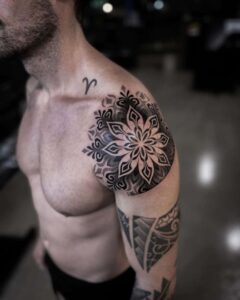Best 8 Mandala Tattoos For Youth
The Intricate World of Mandala Tattoos:
Mandala tattoos have surged in popularity, becoming a favorite choice for those looking for body art with both aesthetic appeal and deep symbolism. These designs, characterized by their intricate patterns and symmetrical beauty, are not merely decorative; they embody a rich history and spiritual significance. In this comprehensive guide, we’ll explore the history of mandala tattoos, discuss their positive and negative aspects, and provide insights into why they have become such a beloved tattoo choice.

1. The History of Mandala Tattoos:
1.1 Ancient Origins:
The word “mandala” is derived from the Sanskrit language, meaning “circle.” In many ancient cultures, particularly within Hinduism and Buddhism, mandalas are sacred symbols representing the universe and spiritual wholeness. They have been used in various spiritual practices and rituals for thousands of years. These geometric designs were originally created to aid in meditation, serving as visual aids that represent the cosmic order and divine harmony.


1.2 Cultural Significance:
In Hindu and Buddhist traditions, mandalas are integral to religious practices. They often serve as diagrams or tools for meditation, helping practitioners focus their minds and connect with the divine. Mandalas are meticulously designed, featuring complex patterns that are intended to symbolize the universe and the interconnectedness of all things. In Hinduism, they are used in temples as representations of the cosmos and deities, while in Buddhism, they assist in meditation and represent various stages of enlightenment.

1.3 Transition to Modern Tattoos:
The transition of mandalas from spiritual symbols to modern tattoos occurred in the late 20th century. As tattoo culture expanded, artists began incorporating traditional mandala patterns into their designs. This shift allowed people to carry a piece of this rich history and symbolism with them permanently. Today, mandala tattoos are not only seen as artistic expressions but also as symbols of personal and spiritual significance.


2. Positive Impacts of Mandala Tattoos:
Here are some positive impacts of mandala tattoos.
2.1 Deep Symbolism and Meaning:
One of the most compelling aspects of mandala tattoos is their profound symbolism. Mandalas represent a wide range of concepts, including balance, harmony, and spiritual growth. For many individuals, a mandala tattoo serves as a powerful reminder of their journey towards inner peace and self-discovery. The circular pattern of the mandala signifies unity and the cyclical nature of life, making it a meaningful choice for those seeking to embody these values.

2.2 Aesthetic Appeal:
Mandala tattoos are renowned for their stunning visual appeal. The intricate details and symmetrical designs make them a popular choice for those who appreciate fine art. The complexity of mandala tattoos allows for a high level of customization, ensuring that each design is unique to the individual. The beauty of these tattoos often lies in their ability to blend complexity with simplicity, creating a visually captivating piece of art.

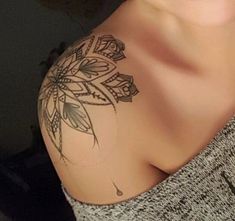
2.3 Versatility in Design:
Mandala tattoos are incredibly versatile. They can be adapted to various sizes and placements on the body, making them suitable for both large and small areas. Whether you prefer a full back piece or a delicate wrist design, mandalas can be customized to fit your preferences. Additionally, mandalas can be combined with other elements, such as floral patterns, animals, or celestial symbols, to create a design that reflects your personal style and meaning.

2.4 Meditative and Reflective Process:
The process of getting a mandala tattoo can be a deeply meditative experience. The intricate nature of the design requires patience and focus, both from the artist and the individual. This process often involves a sense of mindfulness and reflection, which can enhance the overall significance of the tattoo. Many people find that the act of getting a mandala tattoo is a transformative experience that contributes to their personal growth and self-awareness.

2.5 Symbolism of Balance And Peace:
Mandalas symbolize balance, harmony, and unity, reflecting a well-rounded and centered life.
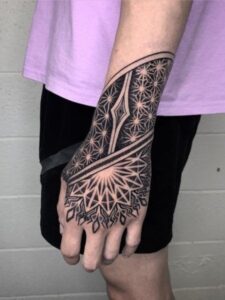
3. Negative Impacts of Mandala Tattoos:
3.1 Pain and Time Commitment:
One of the drawbacks of mandala tattoos is the potential for pain and the time required to complete them. Due to their intricate designs, mandala tattoos often involve long sessions and can be quite painful, especially in sensitive areas of the body. The detailed work necessitates precision and can lead to discomfort during the tattooing process. Additionally, larger and more complex designs may require multiple sessions, extending the overall time commitment.

3.2 Complexity and Cost:
The complexity of mandala tattoos can also result in higher costs. Experienced tattoo artists who specialize in detailed work may charge a premium for their services. The intricate nature of mandalas means that more time and skill are required to execute them properly, contributing to the overall expense. It’s important to budget accordingly and understand that the cost of a mandala tattoo reflects the level of artistry and detail involved.
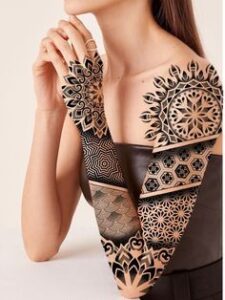
3.3 Fading and Maintenance:
Like all tattoos, mandala tattoos are subject to fading over time. The detailed patterns can blur or lose their sharpness if not properly cared for. To maintain the tattoo’s original beauty, regular touch-ups may be necessary. Proper aftercare is crucial to ensure that the intricate details of the mandala remain clear and vibrant. Neglecting aftercare can result in a loss of definition and impact the overall appearance of the tattoo.
3.4 Cultural Sensitivity:
While mandala tattoos are admired for their beauty, it’s important to approach them with cultural sensitivity. Mandalas have significant spiritual and cultural meanings in various traditions, and appropriating these symbols without understanding their significance can be disrespectful. It’s essential to research and appreciate the cultural context of mandalas before getting one as a tattoo. Respecting their origins and meaning ensures that the tattoo is not only aesthetically pleasing but also culturally respectful.

4. The Process of Getting a Mandala Tattoo:
4.1 Choosing the Right Design:
Selecting the right mandala design is a crucial step in the tattoo process. Take the time to research various patterns and symbols to find one that resonates with you. Consider the meaning behind different mandala designs and how they align with your personal beliefs and values. Working with a skilled tattoo artist can help you refine your design and ensure that it meets your expectations.
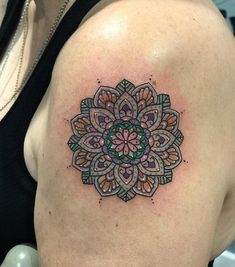
4.2 Finding an Experienced Tattoo Artist:
Given the complexity of mandala tattoos, finding a skilled and experienced artist is essential. Look for artists who specialize in detailed and intricate designs, and review their portfolios to ensure their style matches your vision. Recommendations from friends or online reviews can also help you find a reputable artist. A skilled tattoo artist will have the expertise to bring your mandala design to life with precision and artistry.

4.3 Preparing for Your Tattoo Session:
Proper preparation is key to a successful tattoo session. Ensure that you are well-rested and hydrated before your appointment. Wear comfortable clothing that allows easy access to the area where you will be tattooed. Consider bringing items to keep yourself occupied during the session, such as snacks or a book. Being prepared can help make the process smoother and more enjoyable.
4.4 Aftercare and Healing:
Aftercare is crucial for the healing and longevity of your mandala tattoo. Follow your artist’s instructions carefully, which typically include keeping the tattoo clean and moisturized, avoiding direct sunlight, and refraining from swimming until the tattoo is fully healed. Proper aftercare will help prevent infection and ensure that the intricate details of your mandala tattoo remain sharp and vibrant.

5. Popular Mandala Tattoo Designs:
5.1 Floral Mandalas:
Floral mandalas combine the intricate patterns of mandalas with the beauty of flowers. These designs often symbolize growth, renewal, and the natural world. Floral mandalas can range from simple flower shapes to complex arrangements, offering a wide range of aesthetic options. They are popular among those who appreciate the symbolic connection between nature and spirituality.
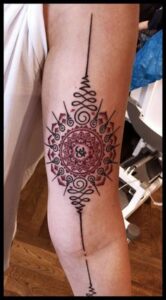

5.2 Geometric Mandalas:
Geometric mandalas focus on precise shapes and symmetrical patterns. These designs often appeal to those who appreciate mathematical beauty and balance. Geometric mandalas can vary from simple shapes to highly complex patterns, providing a wide range of visual options. They are ideal for those who enjoy clean lines and structured designs.

5.3 Animal-Inspired Mandalas:
Animal-inspired mandalas incorporate animals into the mandala design, representing qualities associated with the chosen animal. For example, a lion mandala may symbolize courage and strength, while a butterfly mandala might represent transformation and freedom. These designs offer a way to connect personal symbolism with the beauty of mandala patterns.



5.4 Spiritual Mandalas:
Spiritual mandalas emphasize symbols and elements from various spiritual traditions. These designs can include chakras, lotus flowers, or other sacred symbols, highlighting the spiritual significance of the mandala. Spiritual mandalas are often chosen by individuals seeking to embody specific spiritual concepts or to enhance their personal growth.


6. Personal Stories and Experiences:
6.1 Testimonials from Mandala Tattoo Enthusiasts:
Hearing from individuals who have mandala tattoos can provide valuable insights into their significance and impact. Many people share stories of how their mandala tattoos have positively influenced their lives, serving as reminders of personal achievements or spiritual milestones. These testimonials can offer a deeper understanding of the emotional and psychological benefits of mandala tattoos.
6.2 Emotional Connection:
Mandala tattoos often hold deep emotional significance for those who choose them. They can represent personal journeys, spiritual connections, or tributes to loved ones. Understanding the emotional connection behind a mandala tattoo adds another layer of appreciation for its beauty and meaning. For many, the tattoo becomes a cherished part of their identity and personal narrative.

7. Mandala Tattoos in Popular Culture:
7.1 Influence in Modern Art and Media:
Mandala tattoos have made a significant impact on modern art and media. Their intricate patterns and symbolism are often featured in contemporary artwork, fashion, and design. The visual appeal of mandalas has inspired artists and designers across various mediums, making them a prominent feature in popular culture. From album covers to clothing lines, mandalas continue to influence and captivate audiences worldwide.


7.2 Social Media and Mandala Tattoos:
Social media platforms have played a major role in popularizing mandala tattoos. Tattoo artists and enthusiasts share their designs and stories on platforms like Instagram and Pinterest, showcasing the beauty and versatility of mandala tattoos. This exposure has contributed to the widespread appreciation and adoption of mandalas in tattoo art. Social media also provides a space for individuals to connect with others who share their interest in mandala tattoos, creating a community of like-minded individuals.


7.3 Celebrity Endorsement:
Celebrities and public figures have also contributed to the popularity of mandala tattoos. Many well-known personalities have chosen mandala designs for their tattoos, further enhancing their appeal and visibility. The endorsement of mandalas by influential figures has helped to elevate their status in the world of body art and fashion, making them a sought-after choice for tattoo enthusiasts.

8. Choosing the Right Mandala Tattoo For You:
8.1 Reflecting on Personal Values:
When selecting a mandala tattoo, it’s important to reflect on your personal values and the message you want to convey. Mandalas can symbolize a wide range of concepts, from spiritual enlightenment to personal growth. Consider what aspects of the mandala resonate with you and how they align with your life journey and beliefs. This reflection will help you choose a design that holds meaningful significance.
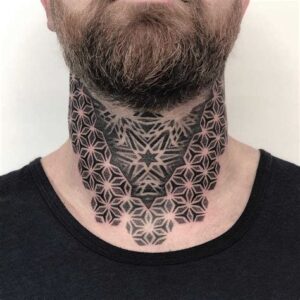
8.2 Customization and Personalization:
Customizing your mandala tattoo allows you to create a design that is uniquely yours. Work with a skilled tattoo artist to incorporate personal elements into the mandala, such as specific symbols, colors, or patterns that have special meaning to you. Personalizing the design ensures that the tattoo is a true reflection of your individuality and personal story.


8.3 Placement and Size:
The placement and size of your mandala tattoo can greatly affect its visual impact and personal significance. Consider where you want the tattoo to be placed on your body and how its size will complement that area. Larger designs, such as full-back mandalas, can make a bold statement, while smaller designs may be more subtle and personal. The placement and size should align with your preferences and how you want to showcase the tattoo.


9. Common Misconceptions About Mandala Tattoos:
9.1 Misunderstanding of Cultural Significance:
One common misconception about mandala tattoos is that they are merely decorative designs without cultural significance. In reality, mandalas have deep spiritual and cultural meanings in various traditions. Understanding and respecting their origins is important when choosing a mandala tattoo. Educating yourself about the cultural context ensures that your tattoo honors its traditional significance.

9.2 Assumptions About Complexity:
Another misconception is that mandala tattoos are too complex and may not be suitable for everyone. While mandalas do feature intricate designs, they can be adapted to suit different tastes and preferences. Whether you prefer a simple geometric pattern or a more elaborate design, mandalas can be customized to fit your style and comfort level.
9.3 Beliefs About Pain and Healing
Some people may be concerned about the pain and healing process associated with mandala tattoos. While the detailed nature of the design can result in longer sessions and potential discomfort, the pain level varies from person to person. Additionally, proper aftercare can help minimize complications and ensure a smooth healing process. Understanding these aspects can help alleviate concerns and prepare you for the tattoo experience.

10. The Future of Mandala Tattoos:
10.1 Emerging Trends:
As tattoo art continues to evolve, new trends and innovations are shaping the future of mandala tattoos. Advances in tattoo technology and techniques are allowing for even more intricate and detailed designs. Artists are experimenting with new styles and interpretations of mandalas, incorporating elements from various artistic movements and cultural influences. Staying informed about emerging trends can inspire you to explore unique and contemporary mandala designs.



10.2 Mandalas in Tattoo Art Education:
The popularity of mandala tattoos has also led to their inclusion in tattoo art education. Many tattoo schools and workshops now offer specialized training in creating mandala designs. This education helps aspiring tattoo artists develop their skills and understanding of mandalas, contributing to the continued growth and innovation in this art form. If you are interested in becoming a tattoo artist, exploring education in mandala tattoo design can enhance your expertise and creativity.

10.3 Expanding Cultural Awareness:
The future of mandala tattoos also involves expanding cultural awareness and appreciation. As more people embrace mandalas as a form of body art, there is an opportunity to deepen understanding of their cultural and spiritual significance. Engaging with the cultural context of mandalas can foster respect and appreciation for their origins, ensuring that their use in tattoo art remains meaningful and respectful.
